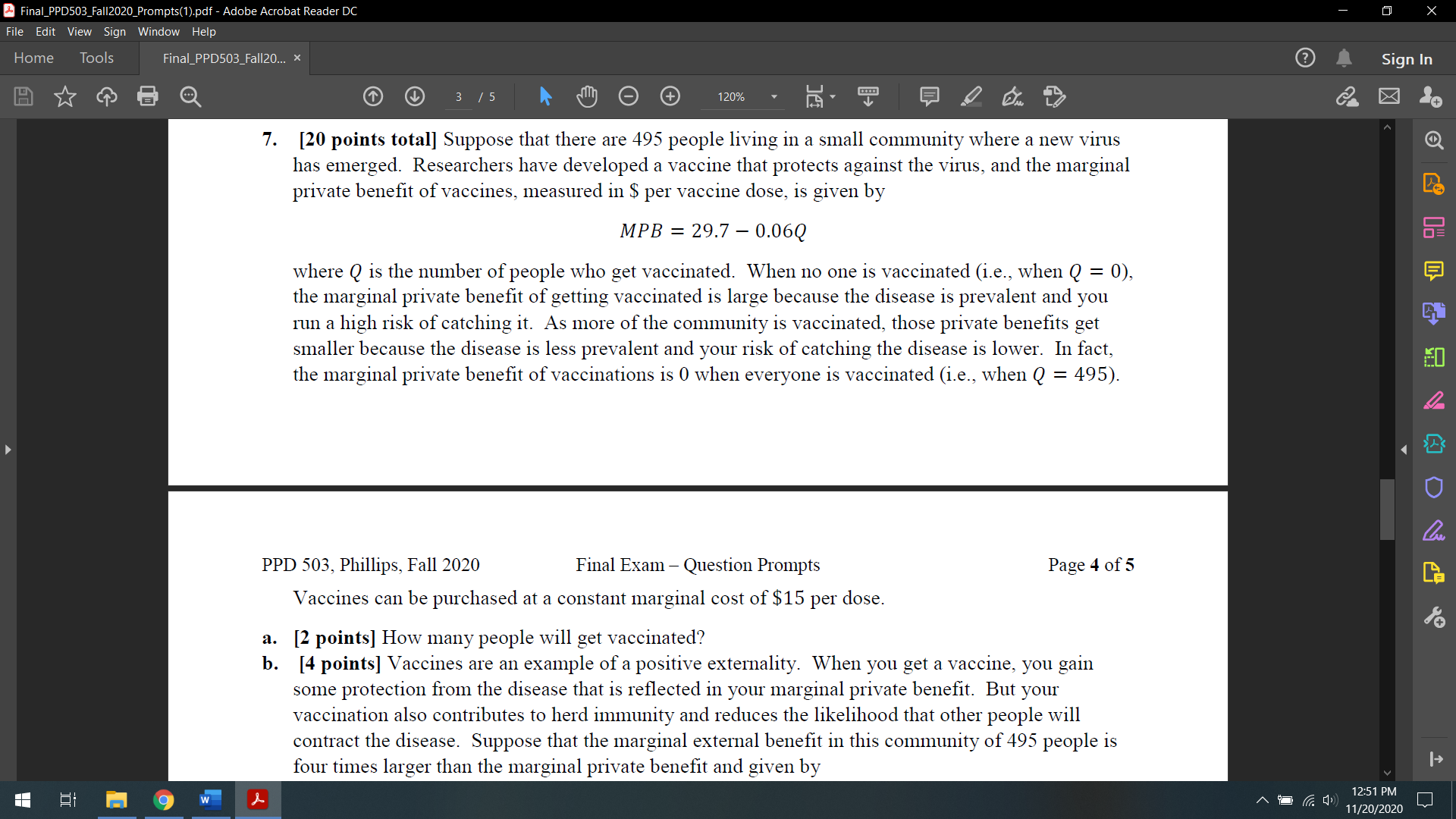Final_PPD503_Fall2020_Prompts(1).pdf - Adobe Acrobat Reader DC X File Edit View Sign Window Help Home Tools Final_PPD503_Fall20... x (? Sign In 3 /5 120% 7. [20 points total] Suppose that there are 495 people living in a small community where a new virus has emerged. Researchers have developed a vaccine that protects against the virus, and the marginal private benefit of vaccines, measured in $ per vaccine dose, is given by MPB = 29.7 - 0.060 where Q is the number of people who get vaccinated. When no one is vaccinated (i.e., when Q = 0), the marginal private benefit of getting vaccinated is large because the disease is prevalent and you run a high risk of catching it. As more of the community is vaccinated, those private benefits get smaller because the disease is less prevalent and your risk of catching the disease is lower. In fact, the marginal private benefit of vaccinations is 0 when everyone is vaccinated (i.e., when Q = 495). PPD 503, Phillips, Fall 2020 Final Exam - Question Prompts Page 4 of 5 Vaccines can be purchased at a constant marginal cost of $15 per dose. to a. [2 points] How many people will get vaccinated? b. [4 points] Vaccines are an example of a positive externality. When you get a vaccine, you gain some protection from the disease that is reflected in your marginal private benefit. But your vaccination also contributes to herd immunity and reduces the likelihood that other people will contract the disease. Suppose that the marginal external benefit in this community of 495 people is four times larger than the marginal private benefit and given by M 9 W 12:51 PM 11/20/2020Final_PPD503_Fall2020_Prompts(1).pdf - Adobe Acrobat Reader DC X File Edit View Sign Window Help Home Tools Final_PPD503_Fall20... x ? Sign In T 4 + 110% X MEB = 118.8 - 0.24Q. When no one is vaccinated (i.e., when Q = 0), the marginal external benefit of getting vaccinated is quite large. As more of the community is vaccinated, those external benefits diminish because there are fewer unvaccinated people left to benefit from the herd immunity. For instance, the marginal external benefit of vaccinations is 0 when everyone is vaccinated (i.e., when Q = 495). What is the efficient quantity of vaccinations? c. [4 points] In a well-drawn and well-labeled diagram, with quantity on the horizontal axis and price on the vertical axis, show your answers to parts a and b. Also, show the deadweight loss associated with the inefficient provision of vaccines from part a. [Be sure to label all curves in the graph. Your graph need not be drawn to scale, but your answers to parts a and b must be evident, along with the deadweight loss.] d. [4 points] Suggest a Pigouvian subsidy (measured in $ per vaccine) that could correct the externality problem. How many people would get vaccinated if your subsidy is implemented? How large is deadweight loss if your subsidy is implemented? e. [2 points] As an alternative to the subsidy in part e, suppose that the government requires that insurers pay for vaccines with no out-of-pocket cost to the individual. (For simplicity, assume that everyone in this community has health insurance.) How many people would get vaccinated under this regulation? f. [2 points] Suppose that people are ill informed about the benefits of vaccinations. People believe (and therefore make decisions based on) an incorrect assumption that the private benefits of vaccinations are only a third as large as they truly are. In other words, people make decisions as if to MPB = 9.9 - 0.02Q even though MPB = 29.7 - 0.06Q in reality. How many people get vaccinated under the Pigouvian subsidy that you proposed in part d? How many people get vaccinated under the insurance coverage mandate from part e? g. [2 points] Referring to your answers from part f, explain how the existence of misinformation regarding vaccines' benefits affects the desirability of the subsidy vs regulatory approaches M 9 w 12:51 PM 11/20/2020








